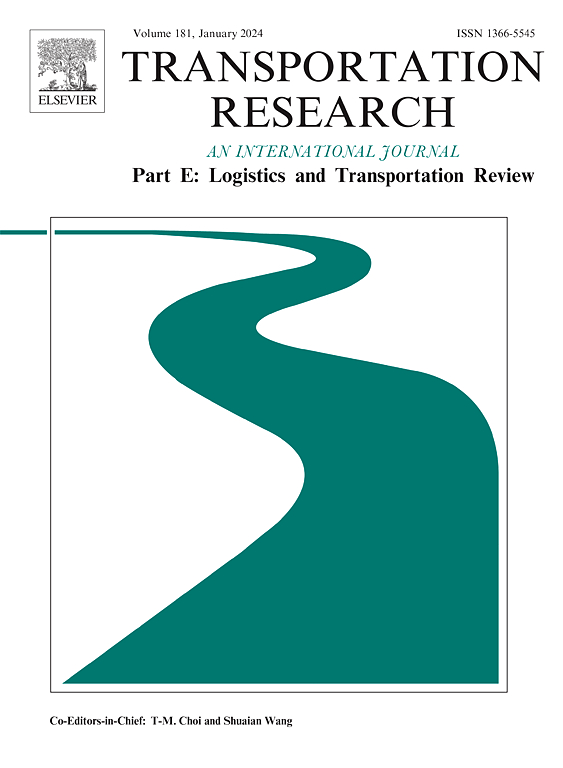SPPformer:一个基于变压器的模型,具有稀疏关注机制,用于全面和可解释的船舶价格分析
IF 8.3
1区 工程技术
Q1 ECONOMICS
Transportation Research Part E-Logistics and Transportation Review
Pub Date : 2025-04-25
DOI:10.1016/j.tre.2025.104136
引用次数: 0
摘要
准确预测多船型船舶价格,为航运企业、投资机构和政策制定者提供科学决策支持至关重要。然而,传统的统计方法和机器学习模型在准确性、泛化性、适用性、可解释性和数据覆盖范围等方面存在明显的局限性,不足以在复杂的航运市场中进行高精度预测。受ChatGPT等基于Transformer的模型在多个领域成功应用的启发,本研究提出了一种基于Transformer架构的新型船舶价格预测模型——sppformer。该模型集成了架构优化、预训练和微调技术,能够对多种船型进行全面的价格预测。在数据方面,本文整合了12个海事相关领域的100多万个数据变量,对模型进行预训练,形成了具有基础时间序列处理能力的Basic model。随后,通过微调将特定领域的海事数据纳入到分部模型中,以提高其在航运部门的专业化。为了提高可解释性,将SHAP方法嵌入到SPPformer预测框架中,可视化预测过程中特征变量对目标变量的影响。在效率方面,引入了一种结合Atrous Self-Attention和Local Self-Attention的稀疏注意机制,取代了传统Transformer的全局注意机制,显著提高了训练效率,解决了过拟合问题。实证研究的重点是预测干散货、集装箱、油轮和整个航运市场的新造船和二手船价格。结果表明,SPPformer模型在精度和可解释性方面优于传统模型。同时,与全局注意机制相比,稀疏注意的引入使训练时间和记忆使用分别减少了22.91%和26.12%。本研究为航运企业提高经济效益和金融机构管理风险提供了重要参考。为政府规范市场秩序、促进航运业稳定发展提供数据驱动支持和分析框架。本文章由计算机程序翻译,如有差异,请以英文原文为准。
SPPformer: A transformer-based model with a sparse attention mechanism for comprehensive and interpretable ship price analysis
Accurate prediction of vessel prices across multiple ship types is crucial for providing scientific decision-making support to shipping enterprises, investment institutions, and policymakers. However, traditional statistical methods and machine learning models face significant limitations in accuracy, generalization, applicability, interpretability, and data coverage, rendering them inadequate for high-precision forecasting in the complex shipping market. Inspired by the successful application of Transformer-based models like ChatGPT across various domains, this study proposes a novel ship price prediction model based on the Transformer architecture—SPPformer. The model integrates architectural optimization, pre-training, and fine-tuning techniques to enable comprehensive price forecasting for multiple ship types. On the data front, this paper consolidated over one million data variables from 12 maritime-related domains to pre-train the model, forming a Basic Model with foundational time-series processing capabilities. Subsequently, domain-specific maritime data were incorporated through fine-tuning to develop the Sectional Model, enhancing its specialization in the shipping sector. For interpretability, the SHAP method was embedded into the SPPformer prediction framework to visualize the impact of feature variables on target variables during the forecasting process. In terms of efficiency, a sparse attention mechanism was introduced by combining Atrous Self-Attention and Local Self-Attention, replacing the global attention mechanism of traditional Transformer, thereby significantly improving training efficiency and solving overfitting issues. The empirical study focused on predicting newbuilding and secondhand vessel prices for dry bulk, container, tanker, and the overall shipping market. The results demonstrate that the SPPformer model outperforms traditional ones in accuracy and interpretability. At the same time, the introduction of sparse attention reduces training time and memory usage by 22.91 % and 26.12 %, respectively, compared to global attention mechanisms. This research provides essential references for shipping enterprises to enhance economic efficiency and for financial institutions to manage risks. It also offers data-driven support and analytical frameworks for governments to regulate market order and promote the stable development of the shipping industry.
求助全文
通过发布文献求助,成功后即可免费获取论文全文。
去求助
来源期刊
CiteScore
16.20
自引率
16.00%
发文量
285
审稿时长
62 days
期刊介绍:
Transportation Research Part E: Logistics and Transportation Review is a reputable journal that publishes high-quality articles covering a wide range of topics in the field of logistics and transportation research. The journal welcomes submissions on various subjects, including transport economics, transport infrastructure and investment appraisal, evaluation of public policies related to transportation, empirical and analytical studies of logistics management practices and performance, logistics and operations models, and logistics and supply chain management.
Part E aims to provide informative and well-researched articles that contribute to the understanding and advancement of the field. The content of the journal is complementary to other prestigious journals in transportation research, such as Transportation Research Part A: Policy and Practice, Part B: Methodological, Part C: Emerging Technologies, Part D: Transport and Environment, and Part F: Traffic Psychology and Behaviour. Together, these journals form a comprehensive and cohesive reference for current research in transportation science.

 求助内容:
求助内容: 应助结果提醒方式:
应助结果提醒方式:


